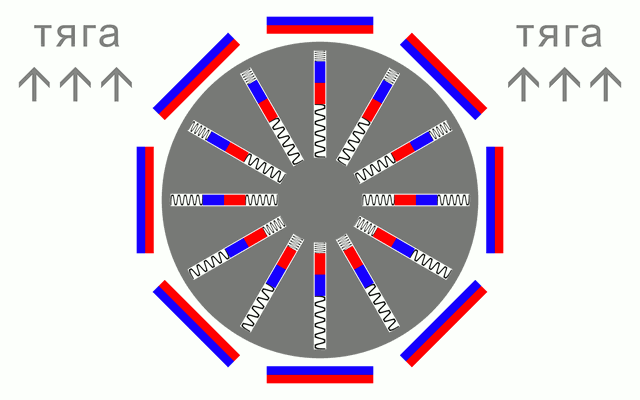Gravity engine (or another stupid idea)
The gravity generator has long been known - it is a centrifuge. And the greater the radius of rotation at a constant angular velocity (number of revolutions per second), the stronger the centrifugal force.
And if you make a "centrifuge" with a variable radius of rotation, will there be a thrust?

Actually, the principle is simple: centrifugal force acts on the rotating magnets, they transfer pressure to the rotor.
The magnets on the stator repel from below / attract rotor magnets from above and change the radius of their rotation.
Since the rotation radius is different, if I am not mistaken, the pressure on the upper part of the rotor (in this variant) will turn out to be uncompensated, and when the rotor rotates, thrust must arise.
')
Springs are needed for depreciation, so as not to break the rotor, and to help return the magnets.
Of course, when using electromagnets on the stator, the direction of thrust can be quickly changed, and in order to compensate for the torque, it is possible to make two “centrifuges” rotating in different directions.
Perhaps, of course, this will not work, but I will not be able to check the thought in the near future, so let it be in the form of a “concept” for the time being. If someone comes in handy - on health.
If suddenly it even works - please consider the device as public domain (public domain) and not patent it . :)
And if you make a "centrifuge" with a variable radius of rotation, will there be a thrust?

Actually, the principle is simple: centrifugal force acts on the rotating magnets, they transfer pressure to the rotor.
The magnets on the stator repel from below / attract rotor magnets from above and change the radius of their rotation.
Since the rotation radius is different, if I am not mistaken, the pressure on the upper part of the rotor (in this variant) will turn out to be uncompensated, and when the rotor rotates, thrust must arise.
')
Springs are needed for depreciation, so as not to break the rotor, and to help return the magnets.
Of course, when using electromagnets on the stator, the direction of thrust can be quickly changed, and in order to compensate for the torque, it is possible to make two “centrifuges” rotating in different directions.
Perhaps, of course, this will not work, but I will not be able to check the thought in the near future, so let it be in the form of a “concept” for the time being. If someone comes in handy - on health.
If suddenly it even works - please consider the device as public domain (public domain) and not patent it . :)
Source: https://habr.com/ru/post/376363/
All Articles